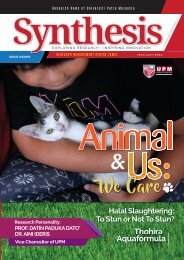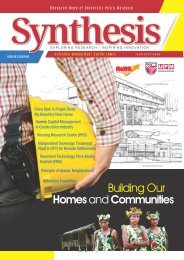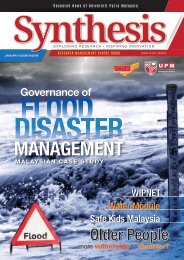SYNTHESIS 3 2019: LANGUAGE COMMUNICATION AND CULTURE
COMMUNICATION has existed since the beginning of mankind, but it was not until the 20th century that people began to study the process. Language is central within a cultural system, shapes speakers’ different assumptions and world views, and is key to communication. It is no doubt that communication plays a very important role in everyone’s life as it can act as a source of information, help people to socialise, and alter an individual’s attitude. Communication and other social sciences researchers draw on each other’s works to study language and culture. During the European Middle Ages and Renaissance period, grammar, rhetoric, and logic constituted the entire trivium, which is the base of the system of classical learning in Europe. The use of various research methods and theoretical frameworks has also resulted in a rich interdisciplinary nature of the work. Therefore, the main goal of this issue is to sketch the negotiations of the areas, and the study of language and culture in the communication disciplines among our researchers.
COMMUNICATION has existed since the beginning
of mankind, but it was not until the 20th century
that people began to study the process. Language
is central within a cultural system, shapes speakers’
different assumptions and world views, and is key to
communication. It is no doubt that communication plays
a very important role in everyone’s life as it can act as a
source of information, help people to socialise, and alter
an individual’s attitude. Communication and other social
sciences researchers draw on each other’s works to
study language and culture. During the European Middle
Ages and Renaissance period, grammar, rhetoric, and
logic constituted the entire trivium, which is the base of
the system of classical learning in Europe. The use of
various research methods and theoretical frameworks
has also resulted in a rich interdisciplinary nature of the
work. Therefore, the main goal of this issue is to sketch
the negotiations of the areas, and the study of language
and culture in the communication disciplines among our
researchers.
You also want an ePaper? Increase the reach of your titles
YUMPU automatically turns print PDFs into web optimized ePapers that Google loves.
Research Highlights
LAJUR AMPUH
Membaca Bahasa Melayu (LAMBM): Innovative
approach to facilitate the learning of Malay Language
“Lajur Ampuh Membaca Bahasa Melayu”
(LAMBM) was invented to help students,
especially pre-school pupils in mastering
the 3M skills in learning (pronounce, spell
and read) the Malay language with ease. The
product was invented due to the rising rate of
illiteracy and the difficulties faced by pupils to
read in Malay. The process of implementing
and shaping this innovation was supported by
the Design and Development Research (DDR)
approach, QAIT Model by Slavin (1994) and
ARCS Motivation Model by Keller (1988).
This syllabus-based learning approach comprises of five
learning techniques in the form of games as teaching
aids, namely sound segments, syllabus cards, syllabus
basic board, syllabus reinforcement boards and syllabic
posters. Each instrument has a level of reading mastery
starting with the introduction of consonants and vowel
letters, the pronunciation of letters, reading the syllables,
forming a combination of two syllables, syllable recovery,
syllable strengthening and syllable enrichment. LAMBM
products were created through the existing knowledge
elements in the form of games and have a reward system
that allows students to actively engage until LAMBM
becomes user-friendly. This product has been through
several trial phases in several schools and among
Malay language subject teachers. Furthermore, the
experimental use of LAMBM in schools represents an
innovation in the teaching and learning process of the
21st century. Overall, interviews and teachers’ feedback
indicate that LAMBM innovation can improve students’
individual and group engagement levels so that weaker
students are more actively involved in the game while
also improving their learning skills. Throughout the
development of this innovative product, the researchers
have actively participated in research and development
exhibition and competitions to further establish this
product. The product has won awards, namely 4-Star
Innovation Award at Selangor Innovation Awards (AINS),
silver and bronze medals for other exhibitions. LAMBM
is expected to be marketed to government and private
schools, preschools and public and private universities.
At the moment, LAMBM is in the packaging and design
process for commercialisation.
Prof. Dr. Vijayaletchumy Subramaniam
Department of Malay Language
Faculty of Modern Languages and
Communication
Tel: +603-9769 8680
Email: vletchumy@upm.edu.my
Co-inventors:
• Nadia Shuhada Abdan Nasir
• Amirra Shazreena Aminul Razin
10 | ISSUE 03/2019










